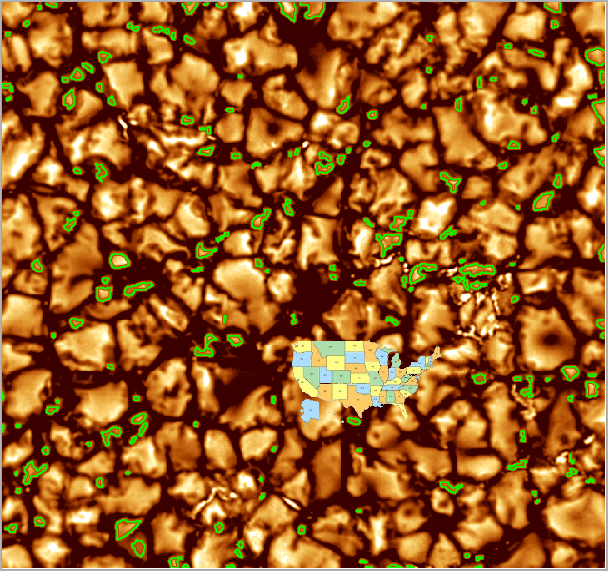

| Visitors Now: | |
| Total Visits: | |
| Total Stories: |

| Story Views | |
| Now: | |
| Last Hour: | |
| Last 24 Hours: | |
| Total: | |
Sharpest Views Of Sunspots And Solar Granulation

Credit: BBSO
Sunspots appear as temporary darker regions on the visible surface of the Sun. They are caused by strong magnetic fields blocking the transfer of heat from the solar interior, allowing the region above to cool. Sunspots are characterised by a darker core or umbra surrounded by a lighter penumbra and are often larger than the Earth.
After a long period of relative calm and few sunspots, activity on the Sun is rising towards an expected peak sometime between 2012 and 2014. At the Big Bear Solar Observatory (BBSO) in California, astronomers are commissioning the New Solar Telescope (NST), an instrument with a mirror 1.6-m across.
The NST is already producing remarkable images like the one above, where details as small as 50 km across can be seen on the disk of the Sun, 150 million km away from the Earth, making it the sharpest ever image of a sunspot. The umbra, penumbra and surrounding granulation (marking convection cells) are all clearly visible.

Credit: Big Bear Solar Observatory
New observations of the solar granulation with the New Solar Telescope (NST) at the Big Bear Solar Observatory (BBSO) allowed a NJIT-Stanford research team to make the next step in understanding of the solar surface structure. A new complex world of very small granules became visible between normal solar granules. Mini-granules, as small as Maine, form a multi-fractal structure, similar to other systems in nature, such as coast lines, glaciers, earthquakes, stock market, etc. A key property of such systems is their unpredictable, burst-like behavior and jagged, irregular shape. Usually, occurrence of numerous independent random processes lead to the formation of a such system. Studying of such systems is beneficial for understanding both the universe and the social life.
The image shows solar granulation acquired with the NST on August 3, 2010 with overplotted contours of detected mini-granules (structures of equivalent diameter less than 600 km). The image size is 20500×19000 km. A map of USA is overplotted for comparison.
Until now it was thought that solar convection produces convection cells, visible on the solar surface as granules, of characteristic (dominant) spatial scale of about 1000km and a Gaussian (normal) distribution of granule sizes. In this case, the mechanism that produces granules is “programmed” to churn up convection cells of a typical size, without much freedom in size variation. Mini-granules do not display any characteristic (“dominant”) scale, their size distribution is continuous and can be described by a decreasing power law (Gaussian distribution does not work any longer here) across all scales ranging from 140 to 2000 km. A majority (about 80%) of mini-granules are smaller than 600 km and about 50% are smaller than 300 km in diameter. This non-Gaussian distribution of sizes implies that a much more sophisticated mechanism, with much more degrees of freedom may be at work, where any very small fluctuation in density, pressure, velocity and magnetic fields may have significant impact and affect the resulting dynamics.
Scientist for long time saw difference in properties of small and large granules. However, low contrast and spatial resolution did not allow scientists to explore the entire range of structures. The NST provides images with contrast twice that of the previous data. It also enables us to see features on the solar surface as small as 80~km. These capabilities allowed us for the first time to accurately detect and measure very small convection cells. Their existence and properties were a subject of debate for long time, and now the NST solves the puzzle of the small (mini) granules.
Original paper titled “Detection of small-scale granular structures in the quiet sun with the New Solar Telescope” by V. I. Abramenko, V.B. Yurchyshyn, P.R. Goode (Big Bear Solar Observatory, NJIT) and I.N. Kitiashvili, A.G. Kosovichev (Stanford University) will be published by Astrophysical Journal Letters at the end of August, 2012
These results were published in Sept 2012 issue of Astrophysical Journal Letters (ADS | Arxiv)


